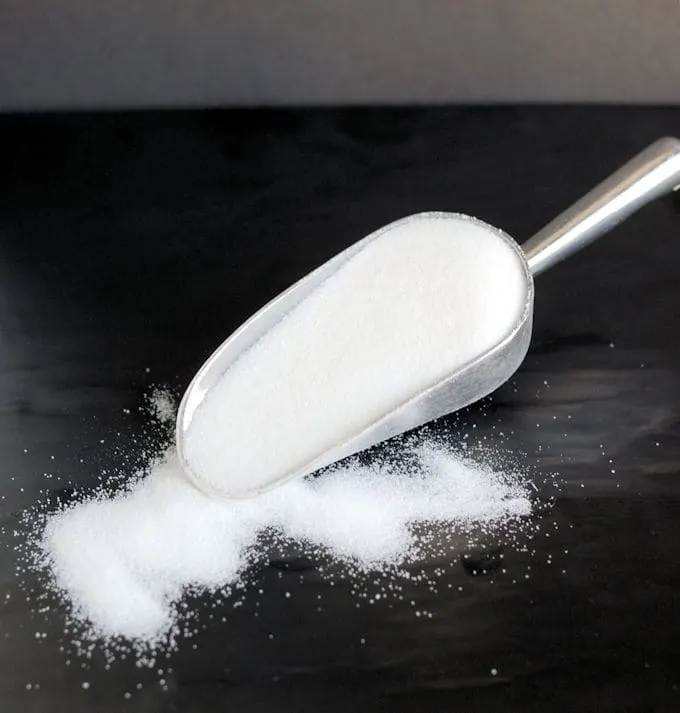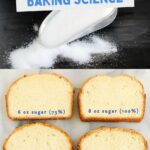🍬 Sugar in Baking
Sugar is a cornerstone of baking — not just because it’s sweet, but because it profoundly affects texture, color, and moisture.
While we’re naturally drawn to sweetness, sugar does far more than please the palate. It balances acidity, controls browning, tenderizes crumb, and even helps baked goods stay fresher longer.

Table of contents
What Sugar Does in Baking
Sugar is hygroscopic, meaning it attracts and holds onto water molecules. This helps baked goods stay soft and moist long after they come out of the oven.
It also interferes with protein coagulation — the process that forms structure in flour and eggs — which produces a more tender, delicate crumb. In other words, more sugar = softer texture (to a point).
Baking Sense Tip
If your cake turned out dense or dry, the sugar level might be too low. Even small changes in ratio can alter crumb texture.
What is Sugar?
All sugars — whether table sugar, honey, molasses, or corn syrup — come from plant sources. Through photosynthesis, plants convert sunlight into glucose, storing energy in the form of complex carbohydrates and simple sugars.
- Table sugar (sucrose) comes primarily from sugar cane and sugar beets.
- Honey is produced when bees concentrate plant nectar.
- Molasses is a byproduct of sugar refining.
Though they differ in flavor and moisture, all play similar structural roles in baking.
Types of Sugar Used In Baking
The scientific name for table sugar is sucrose, a disaccharide made of two simple sugars — glucose and fructose.
Glucose
Found in corn syrup, glucose is less sweet and less water-soluble than sucrose. It prevents crystallization, making it useful for candies, ice cream, and smooth-textured desserts.
Fructose
Sweeter and more soluble than glucose, fructose helps retain moisture in baked goods. It’s what gives honey and high-fructose corn syrup their syrupy texture and heightened sweetness.
Sucrose (Table Sugar)
Sucrose combines the strengths of both glucose and fructose — balanced sweetness, good solubility, and structure-friendly properties. It’s the standard sugar used in most home baking.
Invert Sugar
When sucrose is heated with an acid, it breaks into glucose and fructose. This syrup, called invert sugar, inhibits crystallization (like corn syrup or honey), keeping candies and caramels smooth.
White Sugar vs. Brown Sugar
The difference between white and brown sugar is simple: molasses content.
- White sugar has had all molasses removed.
- Light brown sugar retains a little molasses.
- Dark brown sugar contains even more.
Brown sugar’s extra moisture produces softer, chewier baked goods that stay tender longer, while white sugar yields crisper textures (ideal for thin cookies and delicate pastries).
What is Molasses?
Molasses is the syrup left behind during sugar refining. Each stage of refinement removes more sugar crystals and leaves behind a darker, more intense syrup.
- Cane syrup / light molasses – mild flavor, from the early refining stages.
- Treacle / medium molasses – deeper color and stronger taste.
- Blackstrap molasses – thick, dark, and very strong; used sparingly in baking.
Molasses adds complexity, color, and moisture — especially in recipes like Ginger Snap Cookies or Rye & Molasses Dinner Rolls.
Using Honey in Baking
Honey is typically about 17% water, composed of varying proportions of fructose, glucose, and sucrose depending on its floral source.
When substituting honey for sugar:
- Use about 85% honey by weight compared to sugar.
- Reduce other liquids in the recipe by roughly 15%.
- Expect a slightly darker color and deeper flavor.
Honey helps retain moisture, extending shelf life, and adds beautiful aroma to breads like Milk & Honey Wheat Bread.
Using Maple Syrup in Baking
Maple syrup adds sweetness plus flavor complexity — earthy, caramel, and slightly smoky notes that complement autumn bakes and nut-based desserts.
Since maple syrup is about 34% water, reduce other liquids accordingly when using it as a sugar substitute.
Try it in recipes like Maple Apple Pie or Maple Oatmeal Cookies for warmth and depth.
Sugar Crystal Sizes
Sugar is processed into various crystal sizes, each with unique uses:
| Sugar Type | Crystal Size | Common Uses |
|---|---|---|
| Coarse / Sanding Sugar | Large | Decoration, topping pies and scones |
| Granulated (Table) Sugar | Medium | Everyday baking, most recipes |
| Superfine Sugar | Small | Meringues, whipped cream, beverages |
| Powdered / Confectioners’ Sugar | Extremely fine | Frostings, dusting pastries |
| Demerara / Turbinado Sugar | Large, brown | Crunchy toppings for scones, pies |
If you see “6x” or “10x” on powdered sugar packaging, that indicates how many times the sugar has been ground — 10x being the finest.
📘 Continue Learning
This page is part of my Baking Ingredient Science series, where I explain how each ingredient affects texture, flavor, and structure in baking.
Explore more ingredient guides:
- Flour in Baking – structure and gluten formation
- Fats in Baking – richness and flakiness
- Eggs in Baking – structure and emulsification
- Salt in Baking – balance and control
- Chemical Leavening in Baking – rise and aerate
- Yeast in Baking – fermentation and flavor
- Chocolate in Baking – flavor and structure

